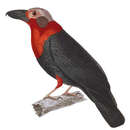Bornean bristlehead (Pityriasis gymnocephala)
provided by EOL authors
The Bornean bristlehead, bristled shrike, bald-headed crow or bald-headed wood-shrike is a medium-sized (25 cm long) black or dark grey bird, with red thighs and a red head, throat and neck, with grey ear-coverts and a crown is covered by short (3–4 mm) yellow or straw-coloured skin projections like bare feather shafts, hence the name 'bristlehead'. The massive, heavy, black, hooked bill and short tail give it a chunky appearance. The white wing-patch is visible in flight and females also have red spots on the flanks. Juveniles have black thighs, red ear-coverts, a red eye-ring, a few red feathers on the head and undeveloped 'bristles'.[7]
It is restricted to Borneo, where it occurs in lowland forests of Sabah and Sarawak, East Malaysia, Brunei and Kalimantan, Indonesia. It lives in the rainforest canopy and occurs mainly in peat swamp forest, but is also recorded from primary evergreen forest, mixed dipterocarp forests and mangroves, logged forest and tall secondary forest up to 1,200 m. Its distribution is sparse, patchy and unpredictable. [3]
It is a noisy species, making various unmusical calls, including distinctive high-pitched nasal whining notes interspersed with harsher notes, chattering noises, whistles, honks and chortles.[2][3][9]. This sociable species often moves steadily in small garrulous flocks of 6-10 birds in the mid and upper canopy of the forest, sometimes accompanied by other large forest birds such as malkohas, babblers, drongos, trogons, woodpeckers and hornbills in mixed-species feeding flocks. Its movements in the canopy are slow and heavy and it flies with a fast, shallow wing-beat.[2][3]
It feeds mainly on large invertebrates, especially orthopterans, phasmids, beetles, lepidopterans, cicadas, cockroaches, termites and spiders, which it gleans from arboreal foliage, twigs, branches and trunks. It will also eat small reptiles, and amphibians and other vertebrates, as well as fruit.[2][3]
It may carry nesting material in flight. An oviduct egg was white with grey and brown spots and dimensions of 31 x 25 mm. Two apparent females seen feeding a fledgling may indicate communal breeding. [3]
BirdLife International rated it as Near Threatened in the IUCN Red List Assessment in 2008. The reviewers were J. Gilroy and S. Butchart. The bristlehead is probably declining quite rapidly throughout much of its range due to habitat destruction and degradation through logging of lowland primary forest and burning of peat swamp forest. it also occurs in less affected forests on slopes and should be carefully monitored. It tolerates logged, secondary and hill forests. Proposed conservation actions include conducting repeated surveys in areas within and surrounding the range to measure rates of population decline or range contraction; conducting ecological studies to improve understanding of its habitat needs, tolerance of secondary habitats and response to fragmentation; campaigning to protect the remaining tracts of peatswamp forest on Borneo. [8]
The bristlehead is sometimes placed in its own family, Pityriaseidae.[2] Its relationships to other birds is controversial. It has been placed in the Prionopidae, Cracticidae, Artamidae or Corvidae.[3][4][5] Some scientists include it in the Tephrodornithidae, a new family including Hemipus and Tephrodornis.[6]

